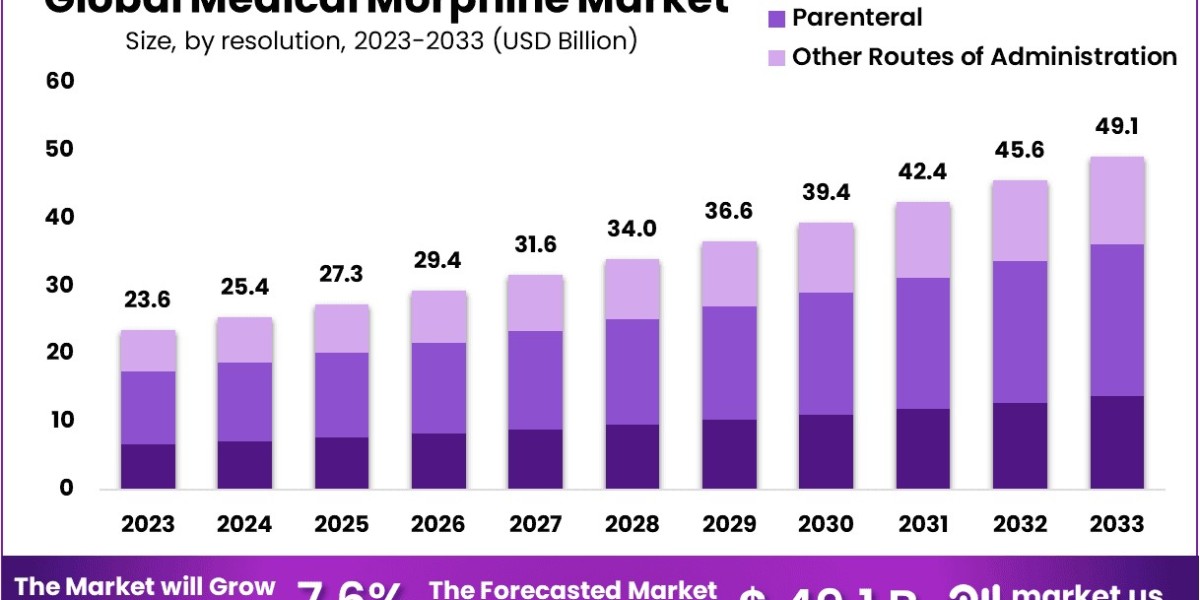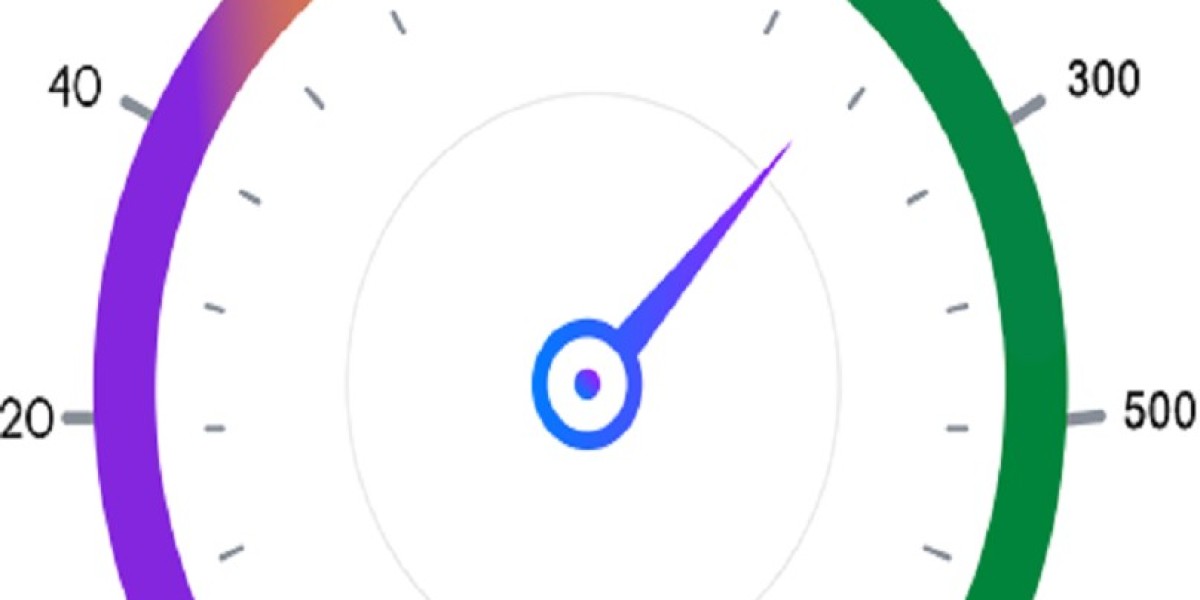Overview
New York, NY – June 11, 2025 – The global medical morphine market is estimated to be valued at US$ 23.6 billion in 2023 and is projected to grow to US$ 49.1 billion by 2033, expanding at a CAGR of 7.6% from 2024 to 2033. This steady growth is fueled by the rising demand for effective pain management across the world. Morphine, recognized by the World Health Organization (WHO) as an essential medicine since 1977, remains vital for treating moderate to severe pain. Its inclusion in public health systems ensures ongoing availability, especially as healthcare needs rise in both high- and low-income nations.
One of the key drivers of this market is the global push to improve palliative care services, especially in underserved regions. Millions still lack access to adequate end-of-life care, particularly in low- and middle-income countries. Organizations like WHO and the Worldwide Hospice Palliative Care Alliance (WHPCA) are working to address this gap. As countries establish or strengthen palliative care networks, the demand for low-cost, effective analgesics like morphine increases. It plays a crucial role in managing pain for terminal illnesses such as late-stage cancer.
In addition to palliative care, the rising prevalence of chronic diseases, post-operative pain, and a growing aging population are expanding the need for morphine. Globally, about 80% of people suffering from pain do not receive proper treatment. This unmet medical need underscores the importance of making opioids more accessible. As healthcare systems in developing countries scale up, morphine becomes central to pain management strategies in hospitals and clinics.
Policy changes and regulatory reforms are also encouraging market growth. WHO and UN agencies are urging countries to strike a balance between opioid control and accessibility. Some nations, like Uganda, have simplified regulatory processes and promoted local morphine production. These efforts help lower costs and improve supply chains, ensuring better access to morphine in both urban and rural healthcare settings. Such reforms support sustainable growth in regional markets.
Finally, global advocacy and educational efforts are helping reduce stigma around morphine use. WHO-led campaigns promote pain relief as a basic human right. Donor-funded programs are building supply systems and training healthcare workers in effective opioid use. Many national health policies now reflect the WHO’s analgesic ladder, further supporting morphine’s use in essential treatment protocols. These coordinated actions are reinforcing morphine’s critical role in global healthcare and driving long-term market expansion.

Key Takeaways
- Market Size: Experts estimate the medical morphine market to reach US$ 49.1 billion by 2033, growing from US$ 23.6 billion in 2023.
- Market Growth: From 2024 to 2033, the market is expected to expand steadily at a CAGR of 7.6%, reflecting rising demand for pain management.
- Route of Administration: Parenteral administration, involving direct injection into the bloodstream, leads the market with 45.8% share due to its rapid and effective pain relief.
- Application Analysis: The cancer treatment segment dominates usage, accounting for 42.2% of the total market in 2023, driven by strong palliative care needs.
- Distribution Channel: Hospital pharmacies hold 39% market share, playing a vital role in delivering quick and controlled morphine access in clinical environments.
- Regional Analysis: North America leads the global market with a 52.3% share, generating revenue of US$ 12.3 billion, largely due to established healthcare infrastructure.
Get sample report: https://market.us/report/medical-morphine-market/request-sample/
Emerging Trends
1. Shift Toward Safer Alternatives
Morphine is effective for pain relief, but it comes with serious side effects. These include the risk of addiction, overdose, and long-term health problems. Because of this, healthcare providers are now exploring new alternatives. These drugs work like morphine but have fewer side effects. Some are less addictive or offer similar relief with lower doses. Scientists are also working on improved formulations that act on pain without affecting the brain too much. This shift shows the growing interest in creating safer options for pain relief. It’s a positive sign that the industry is looking beyond traditional opioids and focusing on long-term patient safety.
2. Focus on Controlled Usage
Hospitals and clinics are being more careful with how they use morphine. They are setting up systems that track every dose given to a patient. These systems help make sure no one is receiving too much or using it incorrectly. Medical staff also monitor how patients respond to treatment. This lets them adjust doses or switch medications if needed. The goal is to reduce the risk of overdose and dependence. More health facilities are making this a standard practice. Controlled usage ensures morphine is used only when necessary and in the safest way possible.
3. Increased Use in Palliative Care
Morphine plays a critical role in palliative care. It is often used to relieve severe pain in patients with terminal illnesses. This includes people in the final stages of cancer or other life-limiting conditions. In these cases, the main goal is comfort. Morphine helps ease pain and anxiety, making the patient feel calm and at peace. As palliative care services grow worldwide, morphine use in this area is also increasing. This trend shows that despite the risks, morphine remains essential for compassionate care. It helps patients live their final days with dignity and less suffering.
4. Global Access Campaigns
In many parts of the world, patients do not have access to morphine. This is especially true in poorer or rural regions. To fix this, governments and healthcare groups are working together. They aim to improve supply chains and simplify rules that limit access. These campaigns focus on educating providers, updating laws, and supporting local distribution. The goal is to make sure people in pain—no matter where they live—can get the medicine they need. This trend shows a growing commitment to equal healthcare. Everyone deserves proper pain relief, and improving access to morphine is a major part of that.
5. Oral and Injectable Innovations
New forms of morphine are being developed to make treatment easier and more comfortable. These include long-acting tablets and gentler injections. Some allow patients to take fewer doses throughout the day. Others are designed to reduce side effects like nausea or drowsiness. These changes help patients stay on treatment and improve their quality of life. Hospitals also benefit, as these options require less supervision. This trend shows how innovation is improving even long-established medications like morphine. Making it easier to use helps both patients and providers manage pain more effectively.
6. Government Regulations Rising
Governments around the world are enforcing tighter rules for prescribing morphine. These rules aim to reduce misuse and ensure the drug is only used when absolutely necessary. Doctors may now need extra approval or documentation before giving morphine. At the same time, they must make sure patients who need it still have access. This balance is not always easy. But it’s part of a larger trend to use opioids more responsibly. These new regulations encourage safer prescribing habits and reduce the risk of addiction. It’s a sign that public health authorities are taking pain management more seriously.
7. Education for Safer Prescribing
Healthcare professionals are now getting better training on how to use morphine safely. This includes learning when to prescribe it, how much to give, and how to monitor for side effects. Many hospitals now require regular updates and workshops for their staff. This education helps reduce mistakes and improve patient safety. It also teaches doctors how to spot early signs of misuse. Proper training is key to balancing effective pain relief with responsible opioid use. As awareness grows, this trend is expected to continue, making morphine use more precise and controlled.
8. Digital Tools for Monitoring
Technology is changing how morphine use is tracked in healthcare settings. Electronic health records and prescription software now allow doctors to monitor each patient’s usage. These tools can alert medical teams if a patient receives too much or asks for frequent refills. They also help coordinate care between different departments. By using digital tools, hospitals can prevent errors and reduce the risk of addiction. It’s also easier to check a patient’s history and make informed decisions. This trend shows that tech can play a big role in safer, more efficient pain management.
Use Cases
1. Post-Surgery Pain Relief
Morphine is often used right after major surgeries. It helps manage severe pain while the body heals. Patients usually feel the most pain during the first few days after surgery. Morphine can be given through an IV, injection, or in some cases, tablets. It allows patients to rest better, which speeds up recovery. Doctors monitor its use closely to avoid any risk of overuse. This is especially important after surgeries like heart, joint, or abdominal procedures. Morphine helps reduce the body’s stress response to pain. That makes the recovery process smoother and more manageable for patients.
2. Cancer-Related Pain Management
Cancer patients often live with chronic and severe pain. This can be from tumors, treatments, or both. Morphine helps manage this pain effectively, especially in advanced stages of the disease. It improves the patient's comfort and allows them to focus on their daily life. The drug is usually part of a broader pain management plan. It may be given in slow-release tablets or liquid form for regular relief. Doctors adjust the dose based on the patient’s needs. This use case shows how morphine can be a vital tool in improving the quality of life for cancer patients.
3. Emergency Trauma Care
Morphine plays a critical role in emergency medicine. When someone suffers a serious injury—like a car accident or a fall—morphine is used to relieve immediate pain. Fast-acting doses are given in ambulances or emergency rooms. This helps calm the patient and allows doctors to begin treatment. It also lowers stress, which can improve survival chances. The goal is to stabilize the patient quickly and reduce suffering. Once the emergency passes, doctors can reassess the pain plan. This shows how morphine is a frontline solution during life-threatening situations involving major physical trauma.
4. Heart Attack Pain
During a heart attack, pain can be intense and overwhelming. Morphine is often used to relieve this pain quickly. It also helps calm the patient, which reduces the heart’s workload. Lower stress and pain levels can help improve oxygen flow and support heart function. Doctors administer it carefully, often through an IV. Morphine is not suitable for every heart patient, so medical staff assess each case. This use is important because it manages not only pain but also emotional distress during a critical moment. It remains a trusted option in many emergency heart care protocols.
5. Hospice and End-of-Life Care
Morphine is commonly used in hospice care. This is where the focus shifts from curing illness to making patients comfortable. People with terminal illnesses often experience pain, anxiety, or difficulty breathing. Morphine helps ease these symptoms and improves their final days. It can be given through oral drops, tablets, or injections. Doctors adjust the dose based on how the patient feels. The goal is not to treat the illness, but to provide relief and peace. In this setting, morphine is seen as a compassionate tool to ensure dignity and comfort at the end of life.
6. Severe Chronic Pain Cases
Some people live with chronic pain that doesn’t respond to regular medications. Conditions like severe arthritis, spinal injuries, or nerve damage may require stronger solutions. In these cases, morphine may be prescribed under close medical supervision. Long-acting tablets or patches are often used to give steady pain relief. Doctors evaluate risks carefully and monitor patients regularly. The focus is on improving daily function and quality of life. Morphine is not the first choice for chronic pain, but it’s an option when other treatments fail. It must be used responsibly to avoid dependency and side effects.
7. During Labor
In some childbirth situations, morphine is used to manage pain. This usually happens in early labor or when an epidural is not available. It helps the mother rest and conserve energy for delivery. The decision to use morphine depends on the stage of labor and overall health. Doctors weigh the benefits and risks, especially for the baby. Morphine is given in controlled doses and is not used close to delivery time. This ensures it doesn’t affect the newborn too much. While not routine, morphine remains a useful option for specific cases in labor management.
8. Severe Burn Treatment
Burn injuries are among the most painful medical conditions. Morphine helps control this intense pain, especially during cleaning, dressing changes, or surgery. Fast pain relief is essential to keep the patient calm and reduce stress. It also makes the medical procedures easier to perform. Morphine can be given through injection or IV, depending on the situation. Burn care often involves multiple stages, and pain management is critical at every step. This use case shows how morphine supports healing by managing unbearable pain in one of the most traumatic medical scenarios.
Conclusion
In conclusion, the global medical morphine market is growing steadily due to its key role in pain management, especially for cancer, surgery, and palliative care. Its recognition as an essential medicine by the WHO and continued demand in both developed and developing regions ensure its importance in modern healthcare. Efforts to improve access, regulate safe use, and support local production are helping more people receive needed pain relief. Innovations in formulations and digital tracking tools are also making morphine safer and more efficient. With strong support from global health bodies and increasing awareness, morphine remains a vital solution in managing severe and chronic pain worldwide.
Contact us on
Market.us (Powered By Prudour Pvt. Ltd.)
Email: inquiry@market.us
Address: 420 Lexington Avenue, Suite 300,
New York City, NY 10170, United States
Tel: +1 718 618 4351







